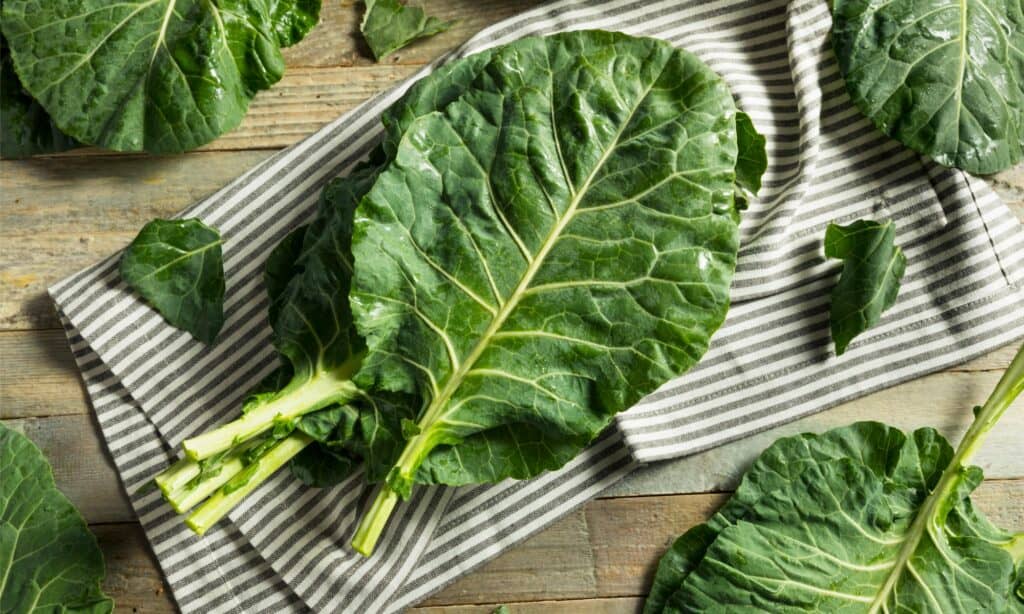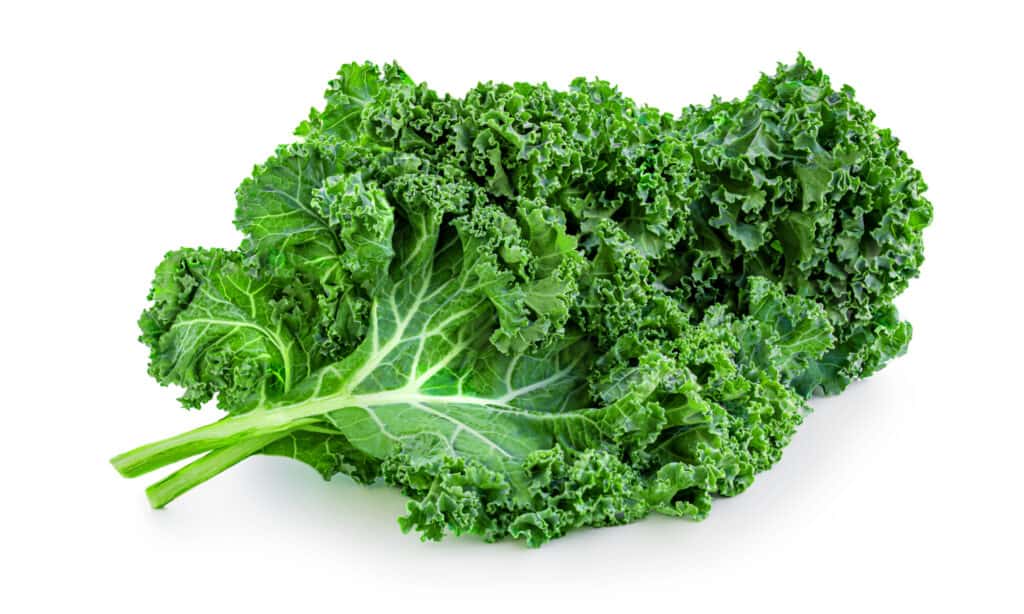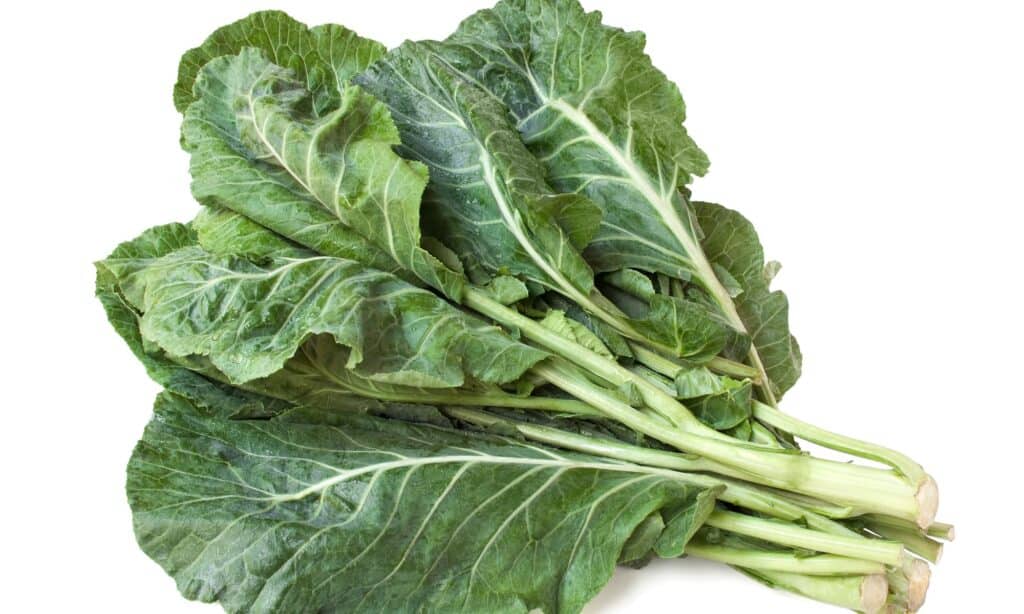Given the fact that they belong to the same plant family, there are a number of undeniable similarities between collard greens vs kale. But what are the differences between these two leafy greens, and how can you learn how to tell them apart upon first glance? If you’re looking forward to learning more about vegetables, you’re in the right place!
In this article, we will compare and contrast collard greens and kale so that you can fully understand these two plants as individuals. We will go over what they look like physically, what they are typically used for, and all of the nutrition you might receive from a single serving. Let’s get started and discuss kale and collard greens now!
Comparing Collard Greens vs Kale

| Collard Greens | Kale | |
|---|---|---|
| Classification | Brassica oleracea subsp. Viridis | Brassica oleracea subsp. Acephala |
| Description | Bundled dark green leaves with veins and scalloped edges. Some stems are present, but leaves are very large and feel like spinach to the touch. Slightly bitter taste, but valued for texture and thickness. | Found in a variety of colors and sizes- there are green, purple, and red varieties of kale. Leaves are ruffled and typically textured in a unique and rough way, with tough stems and chewy leaves. Bitter taste that mellows when cooked. |
| Uses | Used in a variety of cuisines around the world, including India, Africa, Europe and the United States, particularly in the South. Can be eaten raw or sauteed, steamed, roasted, in soups, and more. Taste does not change with age, but the leaves are tastiest in the wintertime | Used around the world in a variety of ways, including in salads, soups, sautees, baking, and more. Flavor mellows when cooked but you may lose some of the nutritional value doing this |
| Nutrition Information | Highly nutritious and full of Vitamin K, A, and C, as well as manganese | Fantastic source of protein, Vitamin K, many other minerals, and iron |
| Special Features and Fun Facts | Built to withstand more frost than spinach, and more heat than lettuce! | Many different varieties of kale available, including ornamental ones! |
Key Differences Between Collard Greens vs Kale

Kale comes in a few different colors, while collard greens are only found in a gray-green shade.
©iStock.com/bhofack2
There are a number of key differences between collard greens and kale. While they both belong to the same plant family and species, collard greens and kale are different subspecies from each other. In addition, the leaves found on collard greens are often larger than the leaves found on the average kale plant. There are many different varieties of kale, but only a few varieties of collard greens.
Let’s go over all of these differences in more detail now.
Collard Greens vs Kale: Classification
There’s a reason that collard greens and kale seem so similar to one another: they are members of the same plant family and species. Both belonging to Brassica oleracea, collard greens and kale are technically different subspecies within this group. Looking at them in more detail, collard greens are classified as Viridis, while kale is classified as Acephala.
Collard Greens vs Kale: Description

Depending on the variety of kale that you are working with, many kale leaves are more textured compared to the flat leaves found on collard greens.
©Natali Zakharova/Shutterstock.com
It should be fairly easy to tell the difference between collard greens and kale if you are looking at them side by side, depending on the kale variety. For example, the leaves of collard greens are typically larger and smoother compared to the small, ruffled greens found on some kale varieties. In addition, kale comes in a few different colors, while collard greens are only found in a gray-green shade.
Depending on the variety of kale that you are working with, many kale leaves are more textured compared to the flat leaves found on collard greens. The stems found on kale are tougher to eat compared to the stems found on collard greens. Both of these greens mellow in flavor should you choose to cook them, but kale loses more nutrients than collard greens when cooked.
Collard Greens vs Kale: Uses

Both are high in vitamins K, A, and C, though kale has more protein compared to collard greens.
©iStock.com/EvergreenPlanet
You can use collard greens and kale for many things, especially when it comes to culinary uses. For example, both kale and collard greens are eaten raw, in soups, sauteed, steamed, and more. Both of these greens are eaten around the world, but collard greens are especially popular in the southern United States, something that can’t be said about kale in particular.
Both of these greens are unique in their ability to handle cold weather. Collard greens are best eaten when they have survived an initial frost, and the same can be said for kale too. In addition, the flavor of collard greens is more mild compared to the flavor of kale, though both of these options are the most delicious in wintertime.
Collard Greens vs Kale: Nutrition Information
Given that they are closely related, collard greens and kale have similar nutritional information to one another. Both are high in vitamins K, A, and C, though kale has more protein compared to collard greens. In addition, collard greens have a decent amount of manganese in a single serving, while kale has a decent amount of iron per serving, depending on what you are looking for.
Collard Greens vs Kale: Special Features

The flavor of collard greens is more mild compared to the flavor of kale, though both of these options are the most delicious in wintertime.
©iStock.com/Tetiana Kolubai
Both collard greens and kale are special for a variety of reasons. Something that may impress you about collard greens is the fact that they are more frost tolerant than spinach, and more heat tolerant than lettuce. When it comes to kale, it has a number of different delicious varieties, including some less edible versions. You can plant ornamental kale in your own backyard, as they are beautiful in color and bring a special touch to any landscaping- plus, you can eat it in a pinch!
Up Next:
- Red Kale vs. Green Kale: What Are the Differences?
- Swiss Chard vs. Collard Greens: What’s the Difference?
- Kale Seeds: How to Grow and Harvest This Leafy Green
The photo featured at the top of this post is © iStock.com/Tetiana Kolubai
Thank you for reading! Have some feedback for us? Contact the AZ Animals editorial team.







